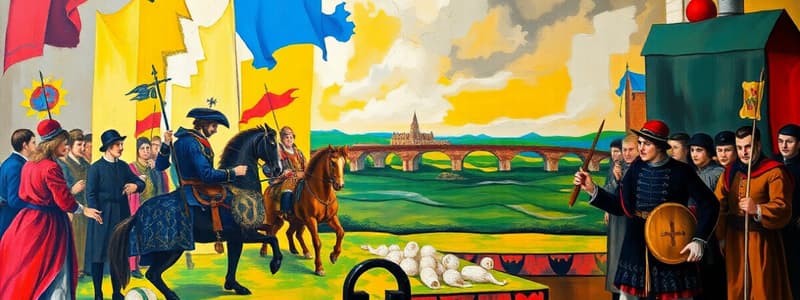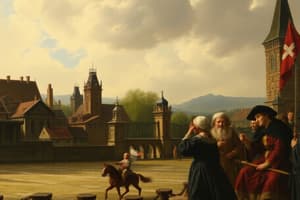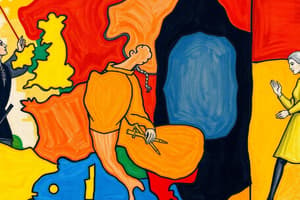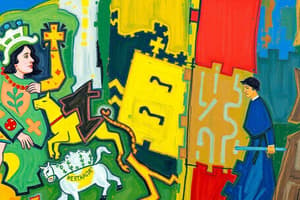Podcast
Questions and Answers
What was one of the outcomes of the Peace of Westphalia?
What was one of the outcomes of the Peace of Westphalia?
- France and Sweden lost territory.
- Spain gained more territory.
- Countries built larger standing armies. (correct)
- The Holy Roman Emperor regained full power.
The Peace of Westphalia allowed for greater freedom of religion among the people in the Holy Roman Empire.
The Peace of Westphalia allowed for greater freedom of religion among the people in the Holy Roman Empire.
True (A)
What percentage of Germany’s population was killed due to the Thirty Years’ War?
What percentage of Germany’s population was killed due to the Thirty Years’ War?
⅓
The Thirty Years' War primarily began as a war over __________.
The Thirty Years' War primarily began as a war over __________.
Match the following countries/regions with their outcomes from the Peace of Westphalia:
Match the following countries/regions with their outcomes from the Peace of Westphalia:
What significant change regarding military strategy did countries adopt after the Thirty Years War?
What significant change regarding military strategy did countries adopt after the Thirty Years War?
Battles during the Thirty Years War mainly took place in France.
Battles during the Thirty Years War mainly took place in France.
What was the main reason the Thirty Years War transitioned from a religious war to a power struggle?
What was the main reason the Thirty Years War transitioned from a religious war to a power struggle?
Who is known as 'The Merry Monarch'?
Who is known as 'The Merry Monarch'?
James the Second was a Catholic ruler who faced little opposition during his reign.
James the Second was a Catholic ruler who faced little opposition during his reign.
What event is referred to as 'The Glorious Revolt'?
What event is referred to as 'The Glorious Revolt'?
After the fall of the Stuart Dynasty, the __________ Dynasty took over the English throne.
After the fall of the Stuart Dynasty, the __________ Dynasty took over the English throne.
Match the following monarchs with their significant actions:
Match the following monarchs with their significant actions:
What document limited the power of the king and queen and affirmed the basic rights of the people?
What document limited the power of the king and queen and affirmed the basic rights of the people?
The role of the Prime Minister became significant during the Hanover Dynasty due to their lack of familiarity with English governance.
The role of the Prime Minister became significant during the Hanover Dynasty due to their lack of familiarity with English governance.
What significant change did England undergo as a result of the events discussed in the content?
What significant change did England undergo as a result of the events discussed in the content?
What concept did Louis XIV introduce to Europe regarding ruling?
What concept did Louis XIV introduce to Europe regarding ruling?
Louis XIV justified his absolute rule by claiming he had the 'Divine Right of Kings'.
Louis XIV justified his absolute rule by claiming he had the 'Divine Right of Kings'.
What was the Palace built by Louis XIV called?
What was the Palace built by Louis XIV called?
Louis XIV referred to himself as the __________ King.
Louis XIV referred to himself as the __________ King.
Match the following terms with their definitions:
Match the following terms with their definitions:
Which of the following factors was NOT necessary for Louis XIV's absolutism?
Which of the following factors was NOT necessary for Louis XIV's absolutism?
What was the main purpose of the Great Council?
What was the main purpose of the Great Council?
Louis XIV's rule lasted for approximately 72 years.
Louis XIV's rule lasted for approximately 72 years.
The House of Lords is elected by the people.
The House of Lords is elected by the people.
What was the main reason for the War of the Spanish Succession?
What was the main reason for the War of the Spanish Succession?
Who was Mary, Queen of Scots?
Who was Mary, Queen of Scots?
Louis XIV believed that 'the state is __________.'
Louis XIV believed that 'the state is __________.'
The Spanish _____ was a powerful naval fleet sent to attack England.
The Spanish _____ was a powerful naval fleet sent to attack England.
Match the following individuals with their roles:
Match the following individuals with their roles:
What was one of the consequences of Louis XIV's wars?
What was one of the consequences of Louis XIV's wars?
Match the following figures with their roles:
Match the following figures with their roles:
What was established as a compromise in religion during Elizabeth's reign?
What was established as a compromise in religion during Elizabeth's reign?
The Edict of Fontainebleau promoted religious diversity in France.
The Edict of Fontainebleau promoted religious diversity in France.
Parliament has always maintained the same level of power in England.
Parliament has always maintained the same level of power in England.
What title is Louis XIV commonly known by?
What title is Louis XIV commonly known by?
What was the main conflict faced by James I in England regarding religion?
What was the main conflict faced by James I in England regarding religion?
Louis XIV made the nobles __________ on him for their wealth and power.
Louis XIV made the nobles __________ on him for their wealth and power.
The Great Council eventually evolved into what is known today as _____ in England.
The Great Council eventually evolved into what is known today as _____ in England.
Match the following houses of Parliament with their characteristics:
Match the following houses of Parliament with their characteristics:
What did Queen Elizabeth I do to manage Parliament's influence?
What did Queen Elizabeth I do to manage Parliament's influence?
James I was well-known for his ability to manage Parliament like Elizabeth I did.
James I was well-known for his ability to manage Parliament like Elizabeth I did.
What was the Gunpowder Plot?
What was the Gunpowder Plot?
The ruling family after Elizabeth I was known as the _____ dynasty.
The ruling family after Elizabeth I was known as the _____ dynasty.
What type of government did the Dutch Republic have?
What type of government did the Dutch Republic have?
The Dutch Republic was dominated by a single religious group.
The Dutch Republic was dominated by a single religious group.
What significant document was signed in England in 1215?
What significant document was signed in England in 1215?
The Dutch Republic is known for its _____ paintings, which showcase scenes of everyday life.
The Dutch Republic is known for its _____ paintings, which showcase scenes of everyday life.
Match the artists with their notable work.
Match the artists with their notable work.
Which statement is true regarding the Dutch Republic's treatment of religious minorities?
Which statement is true regarding the Dutch Republic's treatment of religious minorities?
Calvinism promoted abundance of artwork in public spaces.
Calvinism promoted abundance of artwork in public spaces.
Name one of the painting genres that became popular during the Dutch Golden Age.
Name one of the painting genres that became popular during the Dutch Golden Age.
The leader of England, who signed the Magna Carta, was King _____.
The leader of England, who signed the Magna Carta, was King _____.
Which of the following was NOT a characteristic of the Dutch Republic?
Which of the following was NOT a characteristic of the Dutch Republic?
The Dutch Golden Age is characterized solely by the wealth generated from trade.
The Dutch Golden Age is characterized solely by the wealth generated from trade.
What was the primary reason that attracted thinkers and philosophers to the Dutch Republic?
What was the primary reason that attracted thinkers and philosophers to the Dutch Republic?
The Dutch Republic had colonies and an empire, which made them dominant in _____.
The Dutch Republic had colonies and an empire, which made them dominant in _____.
Which of the following was a focus of art during the Dutch Golden Age?
Which of the following was a focus of art during the Dutch Golden Age?
What was the main objective of the plot that involved gunpowder?
What was the main objective of the plot that involved gunpowder?
King James was well-liked by the Catholics in England.
King James was well-liked by the Catholics in England.
What did Charles I do that angered Parliament regarding taxes?
What did Charles I do that angered Parliament regarding taxes?
Charles I married a Catholic princess, which angered the __________.
Charles I married a Catholic princess, which angered the __________.
Which side in the English Civil War supported the king?
Which side in the English Civil War supported the king?
Oliver Cromwell led the Roundheads during the English Civil War.
Oliver Cromwell led the Roundheads during the English Civil War.
What was the fate of Charles I after being found guilty of treason?
What was the fate of Charles I after being found guilty of treason?
After the execution of Charles I, England was declared a __________.
After the execution of Charles I, England was declared a __________.
Match each term to its correct description:
Match each term to its correct description:
What was one of the strict regulations imposed by Cromwell on society?
What was one of the strict regulations imposed by Cromwell on society?
Cromwell's son was able to maintain his father's strict rules easily.
Cromwell's son was able to maintain his father's strict rules easily.
What major issue did Charles attempt to address by recalling Parliament?
What major issue did Charles attempt to address by recalling Parliament?
Members of Parliament, under Cromwell, were required to be __________ in order to participate.
Members of Parliament, under Cromwell, were required to be __________ in order to participate.
Which philosophical belief did James I uphold that created tension with Parliament?
Which philosophical belief did James I uphold that created tension with Parliament?
The House of Commons assumed all power after the execution of Charles I.
The House of Commons assumed all power after the execution of Charles I.
Flashcards
Peace of Westphalia
Peace of Westphalia
A treaty signed in 1648 that ended the Thirty Years' War in Europe, aiming to establish peace and resolve conflicts. It led to significant changes in religious and political power dynamics.
Impact of Thirty Years' War: German Princes
Impact of Thirty Years' War: German Princes
The Holy Roman Emperor lost significant power during the war, becoming a figurehead, as each prince gained independence to rule their territory.
The Thirty Years' War: Shift in War Aims
The Thirty Years' War: Shift in War Aims
The Thirty Years' War shifted the primary reason for war from religion to power. Countries focused on building up armies to maintain a balance of power and prevent any nation from becoming too dominant.
Impact of Thirty Years' War: Religious Tolerance
Impact of Thirty Years' War: Religious Tolerance
Signup and view all the flashcards
Impact of Thirty Years' War: German Agriculture
Impact of Thirty Years' War: German Agriculture
Signup and view all the flashcards
Thirty Years' War: Population Impact
Thirty Years' War: Population Impact
Signup and view all the flashcards
Thirty Years' War: Impact on Military
Thirty Years' War: Impact on Military
Signup and view all the flashcards
Thirty Years' War: Shifting Power Dynamics
Thirty Years' War: Shifting Power Dynamics
Signup and view all the flashcards
Absolutism
Absolutism
Signup and view all the flashcards
Divine Right of Kings
Divine Right of Kings
Signup and view all the flashcards
Versailles
Versailles
Signup and view all the flashcards
Sun King
Sun King
Signup and view all the flashcards
Louis XIV
Louis XIV
Signup and view all the flashcards
Jean-Baptiste Colbert
Jean-Baptiste Colbert
Signup and view all the flashcards
Edict of Nantes
Edict of Nantes
Signup and view all the flashcards
Edict of Fontainebleau
Edict of Fontainebleau
Signup and view all the flashcards
War of the Spanish Succession
War of the Spanish Succession
Signup and view all the flashcards
Treaty of Utrecht
Treaty of Utrecht
Signup and view all the flashcards
Centralization of Power
Centralization of Power
Signup and view all the flashcards
Bureaucrat
Bureaucrat
Signup and view all the flashcards
Standing Army
Standing Army
Signup and view all the flashcards
Religious Uniformity
Religious Uniformity
Signup and view all the flashcards
Constitutionalism
Constitutionalism
Signup and view all the flashcards
Golden Age
Golden Age
Signup and view all the flashcards
Dutch Republic: Trade and Commerce
Dutch Republic: Trade and Commerce
Signup and view all the flashcards
Dutch Republic: Religious Tolerance
Dutch Republic: Religious Tolerance
Signup and view all the flashcards
Dutch Republic: Intellectual and Scientific Center
Dutch Republic: Intellectual and Scientific Center
Signup and view all the flashcards
Calvinism
Calvinism
Signup and view all the flashcards
Dutch Republic: Calvinist Tolerance
Dutch Republic: Calvinist Tolerance
Signup and view all the flashcards
Dutch Golden Age: Art Shift
Dutch Golden Age: Art Shift
Signup and view all the flashcards
Genre Paintings
Genre Paintings
Signup and view all the flashcards
Still-Life Paintings
Still-Life Paintings
Signup and view all the flashcards
Rembrandt
Rembrandt
Signup and view all the flashcards
Vermeer
Vermeer
Signup and view all the flashcards
Ruisdael
Ruisdael
Signup and view all the flashcards
Magna Carta
Magna Carta
Signup and view all the flashcards
Absolute Monarchy
Absolute Monarchy
Signup and view all the flashcards
The Restoration
The Restoration
Signup and view all the flashcards
The Merry Monarch
The Merry Monarch
Signup and view all the flashcards
James II's Reign
James II's Reign
Signup and view all the flashcards
The Glorious Revolution
The Glorious Revolution
Signup and view all the flashcards
English Bill of Rights
English Bill of Rights
Signup and view all the flashcards
The Hanover Dynasty
The Hanover Dynasty
Signup and view all the flashcards
The Prime Minister
The Prime Minister
Signup and view all the flashcards
Limited Constitutional Monarchy
Limited Constitutional Monarchy
Signup and view all the flashcards
What is the Great Council?
What is the Great Council?
Signup and view all the flashcards
What did the Great Council develop into?
What did the Great Council develop into?
Signup and view all the flashcards
What are the two sections of Parliament?
What are the two sections of Parliament?
Signup and view all the flashcards
How did Queen Elizabeth I manage the relationship between the crown and Parliament?
How did Queen Elizabeth I manage the relationship between the crown and Parliament?
Signup and view all the flashcards
What were some of the major threats to Queen Elizabeth's authority?
What were some of the major threats to Queen Elizabeth's authority?
Signup and view all the flashcards
How did Queen Elizabeth I address the religious issue in England?
How did Queen Elizabeth I address the religious issue in England?
Signup and view all the flashcards
Who was dissatisfied with Queen Elizabeth's compromise religion?
Who was dissatisfied with Queen Elizabeth's compromise religion?
Signup and view all the flashcards
Who became the first Stuart king of England after Elizabeth I's death?
Who became the first Stuart king of England after Elizabeth I's death?
Signup and view all the flashcards
What religious groups were vying for influence during James I's reign?
What religious groups were vying for influence during James I's reign?
Signup and view all the flashcards
What was the Gunpowder Plot?
What was the Gunpowder Plot?
Signup and view all the flashcards
What was the state of religious co-existence during James I's reign?
What was the state of religious co-existence during James I's reign?
Signup and view all the flashcards
How are members of the House of Lords chosen?
How are members of the House of Lords chosen?
Signup and view all the flashcards
How are members of the House of Commons chosen?
How are members of the House of Commons chosen?
Signup and view all the flashcards
What were the key challenges Queen Elizabeth I faced during her reign?
What were the key challenges Queen Elizabeth I faced during her reign?
Signup and view all the flashcards
What is Queen Elizabeth I's lasting legacy?
What is Queen Elizabeth I's lasting legacy?
Signup and view all the flashcards
Cavaliers
Cavaliers
Signup and view all the flashcards
Roundheads
Roundheads
Signup and view all the flashcards
Oliver Cromwell
Oliver Cromwell
Signup and view all the flashcards
The Arrest of the Five Members
The Arrest of the Five Members
Signup and view all the flashcards
The English Civil War
The English Civil War
Signup and view all the flashcards
Charles I's Taxation Policies
Charles I's Taxation Policies
Signup and view all the flashcards
The Commonwealth
The Commonwealth
Signup and view all the flashcards
Lord Protector
Lord Protector
Signup and view all the flashcards
Charles I's Trial
Charles I's Trial
Signup and view all the flashcards
The Long Parliament
The Long Parliament
Signup and view all the flashcards
Parliament's Rules
Parliament's Rules
Signup and view all the flashcards
Split Power
Split Power
Signup and view all the flashcards
Divine Right of Kings (King James)
Divine Right of Kings (King James)
Signup and view all the flashcards
King James and Parliament
King James and Parliament
Signup and view all the flashcards
Study Notes
The Thirty Years' War and its Aftermath
- The Peace of Westphalia (also called the Peace of Exhaustion) was signed in 1648 to end the war.
- France and Sweden gained territory, while Spain lost territory.
- German princes gained independence, diminishing the Holy Roman Emperor's power.
- Religious freedom increased, allowing states to choose their religion (Catholic, Lutheran, or Calvinist).
- Germany suffered widespread agricultural devastation and population loss (⅓).
Impact on Europe
- European powers increased their standing armies, weapons, and ammunition in preparation for future wars.
- Motivations for war shifted from religious conflicts to power struggles.
- European countries sought to prevent any single power from becoming too dominant.
- Religious diversity became permanent, weakening the concept of a unified Christendom.
Louis XIV and Absolutism
- Louis XIV, a French King, embodied absolutism, a system of unrestrained royal power.
- Key components of absolutism included: centralizing power, controlling nobles, developing a bureaucracy, improving taxation, and establishing a strong army.
- Louis XIV justified his absolute rule through the "Divine Right of Kings" (God-given authority).
- He declared "L'état c'est moi" ("The state is me"), implying the absolute fusion of his person and France.
Palace of Versailles
- Versailles, a palace 12 miles outside Paris, became the center of French power.
- Louis XIV compelled nobles to reside at Versailles to maintain control over their activities and wealth.
- Versailles served as a symbol of Louis XIV's power and grandeur.
Religious Policies
- The Edict of Nantes (a previous decree) allowed Huguenots (French Protestants) religious freedom.
- The Edict of Fontainebleau revoked the Edict of Nantes, effectively banning Protestantism in France.
Louis XIV's Wars and Legacy
- Louis XIV embarked on numerous wars to increase France's power and prestige.
- The War of the Spanish Succession was his final major conflict.
- The conflicts led to significant financial strain on France.
- By the end of his reign, despite remaining the richest country in Europe, France confronted internal problems (famine and high taxes).
The Dutch Republic
- The Dutch Republic emerged from the revolt against Spanish rule in the northern provinces.
- The Dutch adopted constitutionalism, limiting the power of its leaders and establishing a central government.
- It fostered commerce and trade, creating a large trading empire.
The Dutch Golden Age
- The Dutch Republic featured religious tolerance, attracting religious refugees.
- Science and philosophy flourished, leading to intellectual advancements.
- The artistic achievements of this period are known as the Dutch Golden Age, characterized by:
- Landscape paintings.
- Genre paintings (scenes of daily life).
- Still-life paintings.
England
- England differed from other European monarchies by its limited monarchy (limited power of the king/queen.)
- The Magna Carta in 1215 established limitations on the king's authority.
- The evolution of Parliament (a Great Council) played a crucial role in limiting the power of the king.
Queen Elizabeth I
- Queen Elizabeth I effectively managed the balance of power between herself and Parliament.
- She suppressed external threats (like Mary, Queen of Scots and the Spanish Armada).
- Elizabeth maintained religious stability through the Elizabethan Religious Settlement.
The Stuart Dynasty
- James I (James VI of Scotland) ascended the English throne, unifying Scotland and England under one monarchy, marking the start of the Stuart Dynasty.
- The Gunpowder Plot, a Catholic attempt to assassinate King James I, highlighted religious tensions.
- James I and later Charles I faced conflicts with Parliament over taxation and power.
Charles I
- Charles I's rule led to escalating conflict with Parliament.
- He dissolved Parliament multiple times, exacerbating issues and leading to civil war.
- The English Civil War pitted the king's supporters (Cavaliers) against Parliament's supporters (Roundheads).
- Oliver Cromwell, leader of the New Model Army, emerged victorious and executed Charles I, establishing a Commonwealth and English Republic.
The Commonwealth Under Cromwell
- Cromwell ruled as Lord Protector of England, creating a Puritan-led republic.
- Cromwell's dictatorial policies led to popular discontent.
- On Cromwell's death, the monarchy was restored.
The Restoration
- Charles II, son of Charles I, became king in the Restoration, ushering in an era of "Merry Monarch."
James II
- James II, Charles II's brother, sparked renewed conflicts with Parliament over religious tolerance.
- The Glorious Revolution deposed James II, ushering in William and Mary.
William and Mary
- William of Orange and Mary II accepted the English Bill of Rights, further limiting the monarchy's power.
The Hanover Dynasty
- The Hanover dynasty, a German house, assumed the British throne.
- The increased role of Parliament led to the emergence of the Prime Minister.
- England transitioned toward a limited constitutional monarchy.
Studying That Suits You
Use AI to generate personalized quizzes and flashcards to suit your learning preferences.




